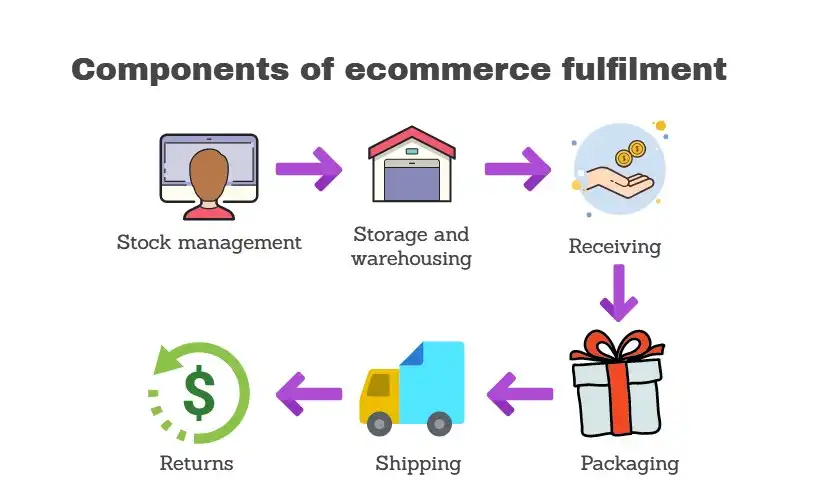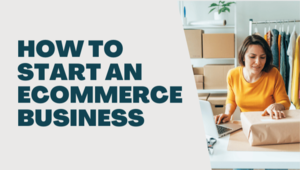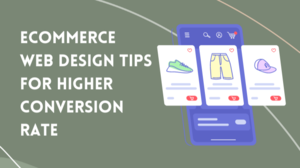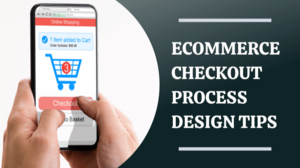The Beginner’s Guide to Ecommerce Shipping and Fulfilment
Fulfilment is the entire process of delivering orders to customers. The process involves everything from storing and handling inventory to packing and shipping them off to corresponding destinations.
While large corporations can handle order fulfilment themselves, small and medium enterprises often outsource the task to specialists. As an ecommerce entrepreneur, you might find the underlying complexities of fulfilment, somewhat unnerving. That is where we come in.
With this in-depth guide to ecommerce shipping and fulfilment, you will be acquainted with all the essential steps and the means to carry them out, in no time, even if you are a beginner.
To start things off, let us dive into the core components of ecommerce fulfilment.
Components of ecommerce fulfilment
Whether you are shipping from your garage or have a dedicated warehouse, in any case, ecommerce fulfilment has six major components.

1. Stock management
Stock management refers to the process involved in ordering, storing and dispatching inventory. Proper stock management is necessary for controlling costs and maximising margins.
2. Storage and warehousing
Whatever goods you deal in, they have to be stored somewhere for eventual distribution. Warehousing does not necessarily mean renting out large industrial spaces for storing your products. Using a garage as your storage unit also counts.
3. Receiving
If you have a dedicated fulfilment department, they will be responsible for receiving ordered products and keeping track of them. Once the products are received, they are assigned individual labels and organised accordingly to simplify future access.
4. Packaging
This component refers to the process of gathering relevant products and packing them with appropriate packaging solutions. The integrity of a product, while shipping, relies heavily on its packaging.
5. Shipping
When your products are packaged, they need to be transported to the end-user. Long-haul shipments usually require air or water transport, whereas local shipments require ground transport.
6. Returns
Customers return products if they do not match the description and/or are damaged during shipping. Under such circumstances, your fulfilment department is responsible for transporting disapproved goods back to the storage and reshipping the new units to associated customers.
Fulfilment methods
Usually, three types of fulfilment methods are followed across all industries. Understanding their pros and cons can help you formulate your strategy.
(a) Self-fulfilment:
Self-fulfilment is exactly what it sounds like. You are responsible for storing, managing and delivering your products to the end-users, on your own. If you started a new business and have yet to get hold of a warehouse or a distributing agent, this is the way to go. This approach is ideal when you are shipping less than 100 items per month.
In addition to being an inexpensive option, self-fulfilment is easy to implement and permits greater control over the process. However, if you plan to scale, you will be better off with a more comprehensive fulfilment approach.
Self-fulfilment, though easy and cost-effective, does not let you harness the benefits from economies of scale. Offering promotional shipping discounts, under this method, can put a large dent in your margins.
(b) Third-party logistics (3PL):
Third-party logistics can take your fulfilment worries away almost instantaneously. Their infrastructure and network of specialists can serve your shipping needs on the go. 3PL services usually deal with storage and management of inventory, packaging, customs brokerage, freight forwarding, cross-docking etc. that might be challenging for a single individual. They serve as an extension to your business while relieving you of the stress.
3PL services are ideal when you are planning to scale. Besides, you can gain access to industry experts and more significant data insights, to optimise your fulfilment process. However, it isn’t easy to find 3PL’s that resonate with your organisational mission. They also inhibit your control over the process. That is a trade-off you have to make for potential growth.
(c) Dropshipping:
This method does not require you to store products on site. Instead, your customers receive products straight from the suppliers. All you have to do is maintain a seamless communication channel between you and your suppliers, and you are good to go.
Dropshipping business needs minimal startup capital, and the fulfilment cost is low. Updating inventory is no hassle if you maintain regular communication with your suppliers. Besides, you only need to pay for the products you sell.
Nevertheless, there are some drawbacks. You lose complete control over the shipping process, and your business is entirely reliant on supplier stock. The margins are also very low, as you cannot purchase products in bulk.
Moreover, customer complaints are directed to you. If your supplier provides faulty products, your brand reputation can deteriorate very fast.
Setting your shipping rates
Figuring out your shipping rates can often be tricky. It is crucial to keep track of your margins and overhead costs while deciding these rates.
Majority of customers prefer free shipping. Free shipping has also been proven to reduce cart abandonment. You can either pay partially for shipping or factor in the entire cost within the product price. We do not recommend paying for shipping entirely from your margins, as it is financially irresponsible, especially for a new business.
What we do recommend is setting a minimum order quantity for availing of free shipping options. Even though you will be paying the shipping cost yourself, the large order quantity will compensate for that.
You can also provide free shipping for loyal customers through coupons. Even though you might make less money on some sales, you are likely to make up for them from the sustained patronage of your customers.
You can also charge real-time carrier rates. Customers pay for the services they choose. If they want super fast delivery, they pay a premium. If they have some time to spare, they can pay for the less expensive options.
Another popular option is to offer flat rate shipping. You do not want to undercharge your customers, sacrificing a considerable portion of your margins; neither do you want to overcharge them at the cost of losing your competitive edge. Finding the right balance is critical.
We do not recommend flat rate shipping if you are selling a wide variety of products. The differences in their sizes and weights can interfere with the flat rate structure and incur losses. Nevertheless, flat rates for local deliveries can boost your sales.
Calculating shipping charges
Shipping charges are usually based on three fundamental factors: product dimensions, product weight, and shipping destination. Insurance and tracking options can incur additional charges. All shipping services have their own framework.
We recommend consulting the ‘Shipping calculator’ available online for almost every shipping and postal service provider. Upon comparison, you will find the sweet spot, that does not drive your prices too high, yet leaves room for a modest margin.
Using a shipping calculator is reasonably straightforward. Take Australia post, for example. You put in the postal code for your area and for the target destination, which will lead you to a page where you can mention the finer details like weight and date of dispatch. Once that is done, you can select your packaging and insurance options.
Top shipping companies in Australia include Willship International, Ausff, Cargo Master, and Orion Shipping.
To produce an effective fulfilment strategy for your growing ecommerce business, you must understand the cost per order. Establishing a base value will help compare your services to others in the industry. It will also help you to speculate margins and optimise them to sustain a competitive edge in the market.
Packaging, presentation, and marketing
Packaging is no longer confined to the mere protection of products; it also plays a significant role in conveying brand messages. You have the option to choose from the utility, branded or boutique packaging solutions.
(a) Utility packaging:
Utility packaging is the basic off-the-shelf solution. They are cheap and available in different shapes, sizes, and forms catering to the dimensions of a wide range of products. If you are on a budget and looking for a robust solution, utility packaging will serve the purpose.
(b) Branded packaging:
Branded packaging comes with customised designs, logos and materials. They are costlier than utility packaging, but you can lower the costs with large quantity orders. Branded packaging is ideal if you have consistent sales and want to incorporate brand experience for the end-user.
Including a ‘thank you card or a coupon within the packages can aid your marketing endeavours. Even when operating overseas, you will be able to establish a connection with your customers through these surprises. You can count on well-executed surprises like this to boost your sales.
(c) Boutique packaging:
Boutique packaging is commonly used for luxury products. If you want to give your customers a unique unboxing experience when they purchase your product, this is the best option. Initially, it can burn a hole in your pocket, but the customers with an appetite for luxury will be more than happy to pay the premium. Moreover, for facilitating that personalised experience, be sure to have adequate time before making the delivery.
Being environmentally responsible, regarding the usage of materials, can help reach a wide range of customers. 60% of Australians prefer sustainable packaging and about fifty per cent are willing to pay more for eco-friendly packaging solutions. When you can cater to these ethical standards, you enhance your brand image and consequently acquire organic clients.
Another essential thing to remember is to optimise your packages in terms of weight and size. These can eat away your margins, especially when you start moving products in large volumes. Having a variety of package sizes and materials can help optimise the associated costs.
Shipping labels
Shipping labels gives you easy access to product information. Ideally, these labels contain the following elements.
- Names and addresses of both the recipient and the sender.
- Details on product weight, dimensions and type.
- Description of the contents within the package.
- Type of chosen shipment facility (Express, standard etc.)
- Tracking number.
Having a comprehensive shipping label makes the products less likely to get lost or rerouted while shipping overseas.
Insurance and tracking
Insured products always intrigue customers to make purchases. Whether you ship products yourself or use a third-party shipping service, insurance and tracking are crucial for instilling a sense of security among the customers.
It is wise to buy insurance for the big-ticket items so that you are reimbursed if the products are lost or damaged in transit. If you are using a third-party service, do some research on their insurance policy to avoid potential losses. Usually, product insurance is included in the shipping cost.
Providing tracking services can facilitate positive customer experiences when they purchase from you. This creates an open communications channel among you, the courier and your customer. It would help if you also incorporated real-time support to keep your customers updated on their purchases.
Clearing customs
If you are operating internationally, it should come as no surprise that you need to deal with customs. Customs declaration forms are usually available at your nearest post office. If you are using a 3PL service, they will take care of all the formalities. Typically, customs documentations include an export declaration, commercial invoice and certificate of origin.
Some products require additional fees upon reaching a country. Usually, the recipient, in this case, the customer, is responsible for paying that off. You will have to be thorough about these in your shipping policy, getting rid of any grey areas that could cause inconvenience for the customers.
You must know the rules and regulations governing the exports to a host country. Without relevant knowledge, your shipping policies will not be very effective and might drive your customers away.
By now, you should have an adequate understanding of ecommerce fulfilment and shipping. You can build your strategy starting from here. Do not hesitate to be creative in terms of packaging and cost-cutting. Always focus on customer convenience while formulating your shipping policies. Lastly, re-evaluate your strategies regularly to keep up with the changing landscape.








